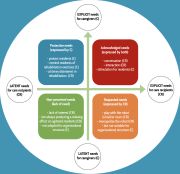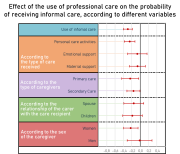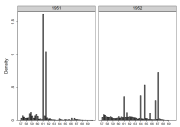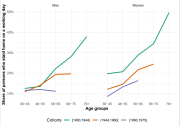
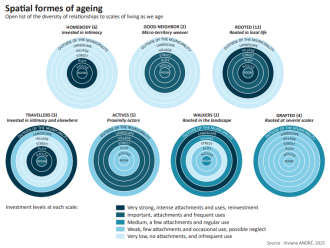
Based on discussions during interviews and workshops, we estimated a level of investment in the scales of living for each individual. Discussions with 55 participants informed the classification, and the 34 individual interviews were classified into these categories. The aim was to highlight the balance of investment between the different scales. We also took into account other elements from life stories and sociological profiles to interpret and create groups.
Viviane André, architect and urban planner, is interested in how older people adapt existing housing in small towns and rural areas.
She observes how residents occupy and transform their living spaces, considering several scales: the house, the plot, the street, the village and the large landscape. Her work complements theories about the shrinking of living space with age. She proposes seven spatial forms of ageing to represent the diversity of relationships to the scales of living as we age.
For this work, Viviane André interviewed 55 people aged 61 to 89 who own detached houses, during five collective mapping workshops and 21 home visits.
She shows that some people invest mainly in their private space, such as “homebodies,” in their house and garden and little outside. The “rooted” invest in their homes and villages, to which they are strongly attached; they will not leave them, even if this constrains them. But some fully occupy other spaces: their street, like the “good neighbors,” or other municipalities, like the “travelers.” Less expectedly, some ageing people occupy more public spaces, such as the “actives”, who are heavily involved in the village and less so in their homes, or the “walkers,” who make intensive use of natural spaces. Finally, while the “grafted” may be very invested in their homes, they are generally less attached to the municipality in which they settled late in life, and are more invested elsewhere.
This multi-scale approach demonstrates that intensive occupation of domestic space in old age is not necessarily interpreted as a withdrawal, but is one form, among others, of recomposing the relationship to space as one ages. It then sheds light on the articulation of the different scales of living in the daily lives of ageing residents.
Statut :
Docteur en sociologie
Affiliations :
Ined, projet AURELIA, Régimes d’autonomie dans le soin de longue durée : instrumentation et territoires. Lauréat du Programme Prioritaire de Recherche (PPR) Autonomie.
